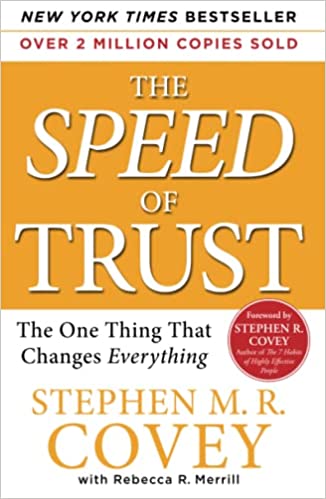The Speed of Trust – Stephen M. R. Covey with Rebecca Merrill

“The Speed of Trust” explores the idea that trust is a key factor in creating and maintaining successful relationships, both personal and professional. It outlines the principles and practices of trust that individuals and organizations can use to increase trust within themselves and with others, and ultimately achieve greater success.
The Business Case for Trust
Trust is not just a social virtue but also a critical economic factor. It impacts almost every measure of performance in organizations, including financial results, speed, innovation, and collaboration. When trust is high, organizations thrive, but when trust is low, everything takes longer and costs more.
The Trust Continuum
Trust is not all or nothing; it operates on a continuum. At one end is low trust, characterized by suspicion and fear, and at the other end is high trust, characterized by openness and collaboration. Most relationships and organizations operate somewhere in between.
Smart Trust
Trust involves risk, but we can manage that risk through “smart trust.” Smart trust involves extending trust in a way that is appropriate to the situation and the level of risk involved. By using smart trust, we can build trust more quickly and effectively.
The 5 Waves of Trust and COVID-19
The COVID-19 pandemic has highlighted the importance of trust in our personal and professional lives. The five waves of trust are especially relevant during this time, as we must build trust with ourselves, our loved ones, our colleagues, our customers, and our society to navigate these uncertain times successfully. Trust is a critical factor in our ability to adapt, innovate, and emerge stronger from this crisis.
The Trust Tax and Trust Dividend
Low trust is expensive, both in terms of time and money. When trust is low, it creates a “trust tax” that slows down work, increases costs, and creates frustration. Conversely, high trust creates a “trust dividend” that speeds up work, reduces costs, and enhances productivity.
Trust Begins with Self-Trust
Before we can build trust with others, we must first trust ourselves. Self-trust involves having confidence in our own abilities, intentions, and values. It also means being honest with ourselves and living in alignment with our principles.
The 5 Waves of Trust
Trust operates like a wave, where each person’s actions either adds to or detracts from the overall level of trust in a relationship or organization. The five waves of trust are self-trust, relationship trust, organizational trust, market trust, and societal trust. Leaders must build trust at each level to create a high-trust culture.
The 4 Cores of Behavior Change
To build trust, we must change our behavior. The four cores of behavior change are understanding the why, starting with the heart, keeping it simple, and making it sticky. Leaders who understand these cores can help their team members change their behavior and build trust.
The Four Cores of Credibility
Credibility is the foundation of trust. The four cores of credibility are integrity, intent, capabilities, and results. These cores are essential to building trust with others and maintaining it over time.
The 13 Behaviors of High-Trust Leaders
Leaders play a critical role in creating and sustaining a culture of trust. The book identifies 13 behaviors of high-trust leaders, including being transparent, demonstrating respect, and creating clarity. Leaders who practice these behaviors build trust with their team members and encourage trust to flourish throughout the organization.

